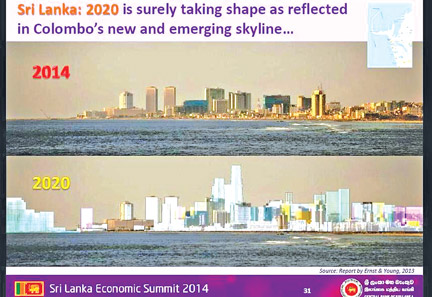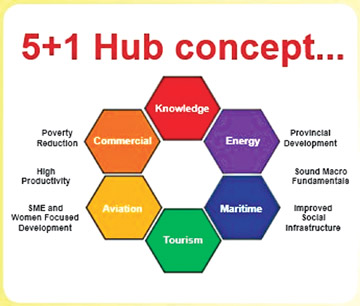|
Vision 2020:
Lanka to be the 'Wonder of Asia'
By Shirajiv Sirimane
The economic losses and the death toll during the 30-year battle
against terrorism is still having its toll. While families are trying to
come to terms with the loss of their loved ones, corporate entities such
as SriLankan Airlines which lost six aircraft by the terrorist attacked
is still recovering the losses. Several five star hotels, The Central
Bank and many other iconic places were attacked by the LTTE.
In this backdrop when the political leaders made pledges during
elections saying that they would end the war and usher permanent peace,
many people did not take it seriously and it was considered a common
political promise that would never be fulfilled.
 The previous four executive presidents could not take bold decisions
to eradicate terrorism and the problem dragged on for nearly 30 years. The previous four executive presidents could not take bold decisions
to eradicate terrorism and the problem dragged on for nearly 30 years.
There were several infamous international issues such as the 'parippu'
drop, bringing down the IPKF which prompted the forward march of
security forces thus giving the upper hand to the LTTE due to political
pressure from overseas.
However, President Mahinda Rajapaksa took several meaningful
decisions locally and internationally and led the world's biggest
humanitarian operation to defeat the world's most ruthless terror
outfit, fulfilling his promise he made.
The second task was to rebuild the war torn nation which was lagging
in infrastructure facilities.The government set up a vision for 2020
with a five-hub concept to elevate the country to a middle income
country by 2020.
A task force was set up and once again far reaching political
decisions were taken and the plan for 2020 was put to practice.
The start of this mega development drive was from the North and East
and billions of rupees were invested to add key infrastructure to the
province ravaged by the war.
Roads were re-laid and after 20 years the Yal Devi train resumed
operations.
Looking back, for nearly a half a century, an average Sri Lankan was
earning around US Dollars 1,500 and in the last few years due to this
economic plan and economic benefits of ongoing rapid development,
trickling down to the masses, per capita income increased to around US
Dollars 3,900 a month.
It took South Korea nearly 40 years after their war to increase the
per capita income to around US$ 7,000. Sri Lanka targets to reach that
milestone by 2020, 11 years after its 30-year battle against terrorism.
Sri Lanka's per capita income would surpass US$ 4,000 by 2015 while
the GDP would reach US$ 100 billion in 2016.
The Real GDP growth which was as 5% in 2000 is expected to be at 7.8%
by end of this year.
The GDP which was at US $ 16.6 billion is predicted to be 77% by 2014
which would be a remarkable growth of 176% in eight years.
The annual inflation for the past five years has being maintained at
a single digit at around 5%. Foreign Direct Investments too is expected
to be around US$ 2 billion this year, GDP is moving steadily towards
greater sustainability from 96.9% in 2000 to 74.3% by end of the year.
In addition by 2020 Sri Lanka targets a GDP that would be around US$ 150
billion.
 By 2020 worker remittances would be mainly from a skilled and
semi-skilled labour force, treated with greater care, dignity and
respect while the financial sector would be stable and would be having a
presence in the region, providing services in Asia. By 2020 worker remittances would be mainly from a skilled and
semi-skilled labour force, treated with greater care, dignity and
respect while the financial sector would be stable and would be having a
presence in the region, providing services in Asia.
By 2020 Sri Lanka sector composition too would undergo a change with
a more modern and high yielding agriculture sector of US$ 10 billion
(6.7%). In 2013 this was at US$ 7.2 billion.
In over five years time, now a more innovative and advanced
industrial sector of US$ 50 billion (33.3%. in 2013 this was at US$ 21.8
billion) and a more broad-based and dynamic services sector of US$ 90
billion (In 2013 at US$ 38.1 billion) too would emerge.
During 2020 the country would have greater market for export of
services. For 2020, Sri Lanka should be among the first 20 countries in
the Doing Business Ranking and would have an investment grade sovereign
rating with a positive outlook.
"The "5 Hubs ++" concept spelled out to take Sri Lanka to be the
Wonder of Asia would have progressed quite well, and each hub as well as
existing drivers of the economy would be operating at enhanced levels."
Aviation
Aviation is yet another sector in which hub status has been envisaged
for Sri Lanka.
With humble beginnings and modest growth over several decades, Sri
Lanka's aviation industry has snowballed into being a key player in the
national economy now providing rapid international access via two
international airports serving the two national carriers and 23 other
carriers connecting 60 destinations worldwide.
The Bandaranaike International Airport (BIA) handled 7.3 million
passenger movements in 2013, 22% in excess of its designed capacity,
exhibiting a remarkable growth of 72% over a period of 5 years and
approximately 19% are transit movements which indicate a growing
potential for achieving passenger hub status.
Cargo operations have also flourished with a throughput of 192,550
metric tons in 2013.
In order to cope with the capacity problem the phase II stage 2 of
BIA development project was launched in September 2014.
The commissioning of the Mattala Rajapaksa International Airport (MRIA)
at Hambantota in March 2013, in addition to enhancing the total national
passenger and cargo handling capacity, has had a positive effect of
increasing the air traffic within Sri Lanka's airspace by 100% with many
operators opting to make their long-haul flights through it, given the
enhanced emergency diversion capacity at Mattala.
These include the ultra-high capacity modern aircraft like the Airbus
380. Amidst these growths, Sri Lanka enjoys, the fifth rank in the Asia
Pacific Region in effective safety implementation as determined by the
ICAO's Universal Safety Oversight Audit Programme (USOAP).
On completion of the BIA development project, its capacity will
increase to 15 million passenger movements per annum.
MRIA too is to be developed to handle 6 million passenger movements
per annum.
Vision 2020 encompasses the increase of the national carrier fleet to
26 aircraft thus gearing the country to attract 4.5 million tourists
annually by year 2020.
MRIA offers lucrative investment opportunities that are directly
linked to aviation as well as those catalysed by it.
A few examples are domestic aviation, MRO (maintenance, repair and
overhaul) services for airlines, freight forwarding, tourism,
hospitality, flying schools, industrial parks, adventure and recreation.
Shipping
It is the first time in the history that five international harbors
are being built and developed. Galle is being transformed as the regions
first leisure harbor while Oluvil would be focusing on the fisheries
sector. In addition the Hambantota Harbor built with Chinese assistance
would be focusing on transshipment while the Colombo South harbor is
being developed to cater to more vessels.
Trincomalee is developed with tourism and cargo and a major
investment zone is created in Hambantota and Trincomalee for port
related activities.
Kankasanthurei is being developed with the assistance of the
government of India to be the fifth international harbor.
With returns on the investment, already coming from both Colombo
South and Hambantota harbors, two artificial islands are also being
developed for leisure and residential activities similar to Palm Dehera
in Dubai.
Knowledge Hub
The high literacy rate and internet access for all Sri Lankans, was
one of the key factors to launch a Knowledge Hub concept. The knowledge
hub targets Information Technology (IT) literacy and internet access for
all, creating knowledge-based jobs, commence degree programs directly
targeting foreign students and accredited foreign universities to set up
university colleges in Sri Lanka.
The energy hub envisages the development of renewable energy sources,
new oil refinery at Hambantota, oil exploration and production in three
sea basins (offshore) which have been identified in Mannar, Cauvery, and
the Southern waters to develop oil trade-related ancillary services
including gas.
Commercial Hub
The commercial hub envisages the establishment of Sri Lanka as the
foremost centre in the region in the provision of commercial services,
international banking and international investments and a Singapore-type
model to be followed via the growth of ports and tourism. The main
challenges here include the development of physical infrastructure,
digital infrastructure, human capital infrastructure and regulatory and
legal infrastructure.
Growth of ports and tourism will be a catalyst to the development of
Sri Lanka's commercial sector. IT parks in Hambantota and IT city in
Colombo too would help to promote this segment.
Tourism sector would be catering to about 4.5 million tourists while
Sri Lankan business conglomerates would be enjoying business
relationships with key Asian, European and US counterparts.
Professionals
With the end of the battle against terrorism and political stability
that was witnessed in the past decades had resulted in private sector
maintaining high balance sheets.
Professionals were identified by President Mahinda Rajapaksa as one
of the most important groups in the society and they were offered
various concessions which included duty free car permits, concessionary
rates of taxes like 16% on employment income, 24% on personal tax and
low interest rate on borrowings.
In addition professionals were given a conducive environment to carry
out their practice by bringing opportunities through foreign investments
and other avenues.
The positive political environment since 2006 helped corporates to
effectively steer the economy out of global crisis and turbulent times
in the recent past.
During the last six to eight years the government has been focusing
on meeting economic targets such as the per capita income, growth rate,
low unemployment, inflation, foreign reserves and other identified
indicators. The government was successful in this regard as the efforts
have come to high praise from the World Bank, International Monetary
Fund and many other institutions.
The developments in the city of Colombo to make it a true
international City with modern facilities under taken by Urban
Development Authority are already being lauded locally and
internationally.
The amasing transformation and restoration of colonial building such
as the Dutch hospital, Race Course and Old Secretariat building near
Independence square long with the introduction of walk ways and green
space is being much appreciated.
These development and the peaceful atmosphere is drawing high end
tourists to Sri Lanka which is resulting in world famous names such as
Hyatt, Shangri La, Movenpick, OZo, Best Western coming in to Sri Lanka.
In addition to make way for the future housing demands several sky
scrapers too are being built.
Sri Lanka has already shown that it is an excellent case study of a
transition from terrorism to peace and development and the targets
mapped in the Vision 2020 plan, would certainly take the country to be
the Wonder of Asia. |

